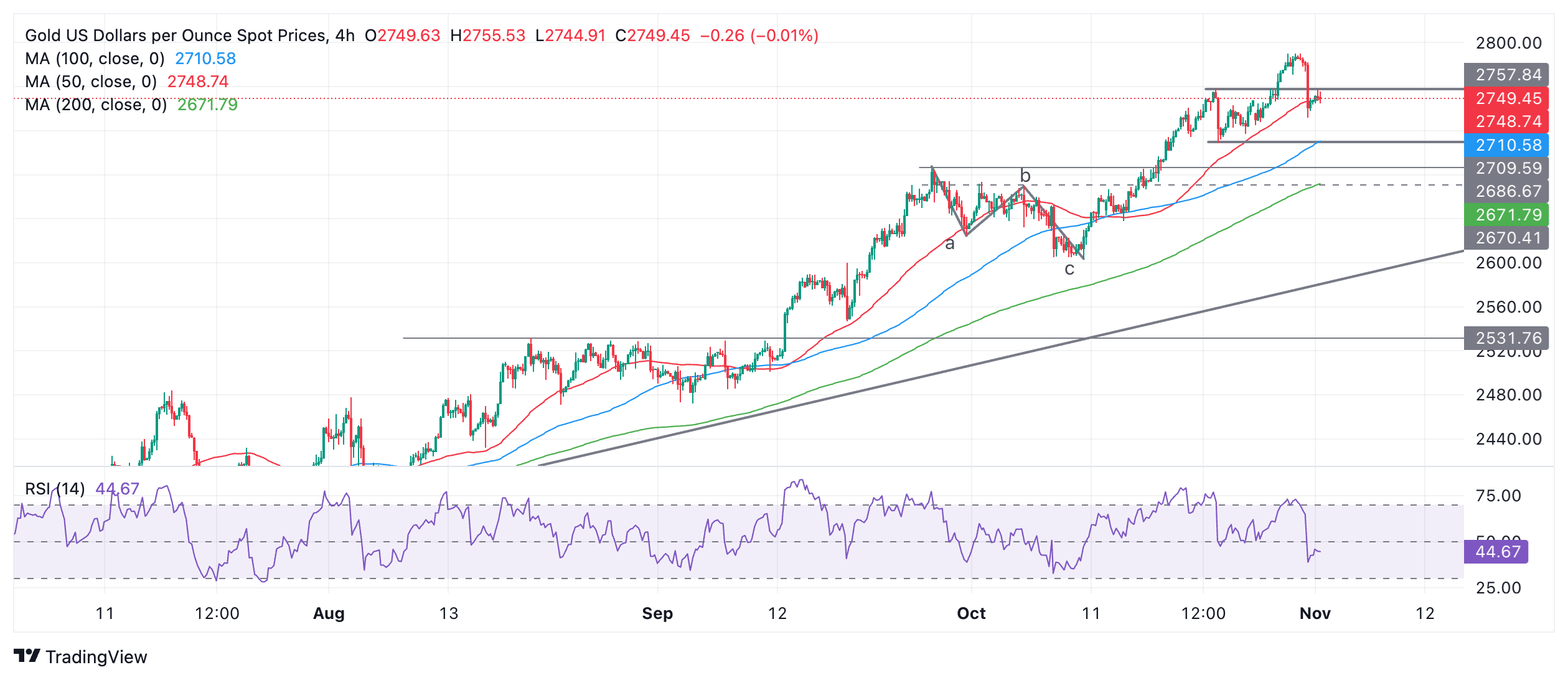Gold edges higher as geopolitical risks revive following Hezbollah attack in Israel
- Gold recovers after the steep sell-off on the previous day amid rising safe-haven flows.
- Hopes of a ceasefire in the Middle East were dashed after Hezbollah launched a rocket attack, killing seven people in northern Israel.
- Gold could be impacted by the release of US Nonfarm Payrolls data on Friday as it could change the outlook for interest rates.
Gold (XAU/USD) edges a third of a percentage point higher on Friday, recovering from the tumble it suffered on the previous day. The precious metal is trading in the $2,750s, just under a key chart resistance level.
Gold is rebounding on the back of a revival in safe-haven demand after hopes of a ceasefire in the Middle East war were dashed by a Hezbollah rocket attack in northern Israel that killed seven people, making it the worst strike in months, according to the BBC. That, and the risk surrounding the US presidential election given how tight the race is, continue leavening demand for the yellow metal.
Gold upside could be capped amid stronger US Dollar
Gold’s recovery could meet fresh resistance, however, as risks remain to the precious metal’s outlook. The US Dollar (USD) is rising on Friday, ending a week-long decline, and this is likely to present headwinds to Gold because it is mainly priced and traded in USD.
The Dollar is rising as markets continue to scale back their expectations for Federal Reserve (Fed) easing because of strong employment data. Although the number of job openings fell unexpectedly, strong private payrolls data and lower unemployment benefit claimants data this week, made up for the openings miss. All these may help reassure the Fed that the labor market is solid.
US Nonfarm Payrolls data out on Friday, however, will be key in gauging the health of the labor market and the Fed’s future interest rate decisions. It will also reveal the Unemployment Rate and Average Hourly Earnings.
If markets radically revise their expectations regarding Fed policy – seeing more not less interest rate cuts on the horizon – Gold could gain a boost and reassert its established uptrend.
Technical Analysis: Gold pulls back into former range
Gold has pulled back down into its former range between $2,708 and $2,758 after rolling over from its new all-time high of $2,790, established on Wednesday.
Overall, the precious metal remains in a steady uptrend on all time frames (short, medium and long), which, given the technical principle that “the trend is your friend,” tilts the odds in favor of more upside.
XAU/USD 4-hour Chart
That said, the decline from Wednesday’s peak has been steep, which could augur more downside to come.
The Relative Strength Index (RSI) momentum indicator in the 4-hour chart is also showing a bearish dip in momentum accompanied by the recent sell-off, with RSI falling substantially below the 50 mark for the first time since October 10.
A deeper pullback would find support at $2,708, the floor of the range. The overall uptrend, however, might resume afterward.
A break above the $2,790 high would probably lead to a move up to resistance at $2,800 (whole number and psychological number) followed by $2,850.
Gold FAQs
Gold has played a key role in human’s history as it has been widely used as a store of value and medium of exchange. Currently, apart from its shine and usage for jewelry, the precious metal is widely seen as a safe-haven asset, meaning that it is considered a good investment during turbulent times. Gold is also widely seen as a hedge against inflation and against depreciating currencies as it doesn’t rely on any specific issuer or government.
Central banks are the biggest Gold holders. In their aim to support their currencies in turbulent times, central banks tend to diversify their reserves and buy Gold to improve the perceived strength of the economy and the currency. High Gold reserves can be a source of trust for a country’s solvency. Central banks added 1,136 tonnes of Gold worth around $70 billion to their reserves in 2022, according to data from the World Gold Council. This is the highest yearly purchase since records began. Central banks from emerging economies such as China, India and Turkey are quickly increasing their Gold reserves.
Gold has an inverse correlation with the US Dollar and US Treasuries, which are both major reserve and safe-haven assets. When the Dollar depreciates, Gold tends to rise, enabling investors and central banks to diversify their assets in turbulent times. Gold is also inversely correlated with risk assets. A rally in the stock market tends to weaken Gold price, while sell-offs in riskier markets tend to favor the precious metal.
The price can move due to a wide range of factors. Geopolitical instability or fears of a deep recession can quickly make Gold price escalate due to its safe-haven status. As a yield-less asset, Gold tends to rise with lower interest rates, while higher cost of money usually weighs down on the yellow metal. Still, most moves depend on how the US Dollar (USD) behaves as the asset is priced in dollars (XAU/USD). A strong Dollar tends to keep the price of Gold controlled, whereas a weaker Dollar is likely to push Gold prices up.

